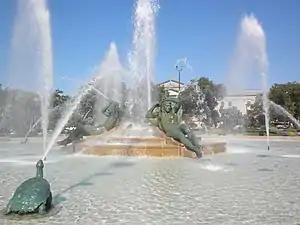Wilson Cary Swann
Wilson Cary Swann (1806 – March 21, 1876) was an American physician, philanthropist, and social reformer. Born in present-day Alexandria, Virginia, he moved to Philadelphia in 1847, and spent the rest of his life there. Swann held around 40 slaves, whom he freed shortly after his marriage in 1847.
Swann had leadership roles in several philanthropic organizations in Philadelphia, including the Society for the Prevention of Cruelty to Animals and the Philadelphia Fountain Society, which financed the construction of numerous drinking fountains in the city. He also maintained a substantial art collection.
Life and education
Swann was born in Alexandria, Virginia (then part of the District of Columbia) in 1806. His father was Thomas Swann, appointed United States Attorney for the District by James Monroe. Swann's brother, Thomas Swann, became governor of Maryland.[1][2]
Swann attended the University of Virginia. He then studied medicine at the University of Pennsylvania, receiving an MD in 1830.[3] He inherited an island in the Potomac River from his father. Together with these real estate holdings, he also took control of his father's slaves.[2] He later constructed a mansion on the Virginia side of the river.[4]
He was married to Maria Bell in October 1847.[3] For some time after his marriage he divided his time between Philadelphia and Virginia. His estate was suffering from his frequent absence, however, and his wife's health was too precarious for travel. Consequently, he sold the estate and emancipated the 40 slaves under his control.[4]
Swann died on March 21, 1876.[5]
Reform efforts
Swann was elected the first president of the local Society for the Prevention of Cruelty to Animals (SPCA). In addition to his leadership of the SPCA, Swann wrote stories for children designed to foster their appreciation for animals.[4]
Swann also served as the first president of the Philadelphia Fountain Society, founded in February 1869, which sponsored the construction of drinking fountains for humans and working animals in the city.[6][4] His aim was in part to "promote temperance and relieve animal suffering".[6]
Union League

When the Civil War began, Swann joined the Union League, and helped to fund the construction of its clubhouse on Broad Street. When the war ended, Swann stated that he was in favor of treating Southerners kindly.[4]
Art collecting
Swann's art collection reportedly included works by Rubens, Titian, Leonardo da Vinci, Murillo, Angelica Kauffman, and Leutze.[4]
Legacy

In 1924, the Philadelphia Fountain Society built the Swann Memorial Fountain in honor of Dr. Swann. The fountain was designed by sculptor Alexander Stirling Calder and architect Wilson Eyre. The fountain is located in Logan Circle, at the midpoint of the Benjamin Franklin Parkway.
References
- "Democratic Reception to Gov. Swann, of Maryland, in Pennsylvania". The Baltimore Sun. May 20, 1871. p. 1. Archived from the original on September 26, 2020. Retrieved September 25, 2020 – via Newspapers.com.
- Robson 1874, p. 113.
- Fairmount Park Art Association 1974, p. 231.
- Robson 1874, p. 114.
- "Obituary: Wilson C. Swann, M.D.". The Philadelphia Inquirer. March 22, 1876. p. 2 – via Newspapers.com
 .
. - Double, Bill. "A Modest Fountain on the Square". Pennsylvania Heritage Magazine. Pennsylvania Historical and Museum Commission. ISSN 0270-7500. Retrieved September 23, 2020.
Sources
- Fairmount Park Art Association (1974). Sculpture of a City: Philadelphia's Treasures in Bronze and Stone. New York: Walker Publishing Company. OCLC 1151158386.
- Robson, Charles, ed. (1874). "Swann, Wilson C.". The Biographical Encyclopædia of Pennsylvania in the Nineteenth Century. Philadelphia: Galaxy Publishing Company. pp. 113–114. OCLC 1041649478.
 This article incorporates text from this source, which is in the public domain.
This article incorporates text from this source, which is in the public domain.